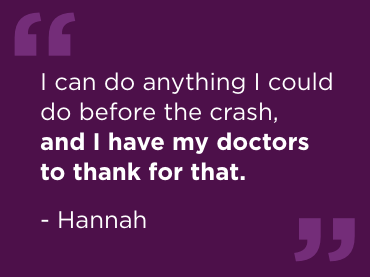The Path to UPMC
Seventeen-year-old Hannah Snyder was facing a critical situation. Lying at the bottom of a 40-foot embankment, upside down in her vehicle, with broken bones and countless cuts and bruises, she tried to recall what just happened.
Dazed, but still coherent, she recalled an out of control vehicle swerving into her lane. Trying to avoid a head-on collision, she lost control of her car, which rolled twice before tumbling down the steep hillside. Now, this high school senior had to act to save her life.
She eventually managed to free herself from the wreckage, but knew something was wrong with her back.
“It just didn’t feel right and I knew in my mind it was broken,” explained Hannah. “But I knew I had to get back up to the road to get help to have any chance of getting out of there.”
She slowly crawled up the embankment and was able to wave down a passing car. The vehicle that caused the crash didn’t stop.
Hannah was immediately life-flighted to a local hospital where doctors evaluated her condition. An x-ray revealed that part of her spine had been badly crushed. Unable to provide the proper treatment, doctors rushed her to UPMC.
Schedule an Appointment or Ask a Question
The Challenge
Neurosurgeons at UPMC confirmed that Hannah had a severe lumbar (lower spine) burst fracture, or a crushing of the bones in the spine from all directions. These bony fragments can spread into surrounding tissues or into the spinal canal, which can cause severe neurological damage and partial or complete paralysis.
Doctors needed to operate quickly in order to remove the fractured pieces of Hannah’s spine before they caused additional and permanent damage. Once she was stabilized, she was prepared for surgery.
The Solution
Using minimally invasive surgery, UPMC neurosurgeons removed the damaged areas of Hannah’s spine and replaced the section with an expandable cage of autograft bone. Rods and screws were then placed to fortify the structure and alignment of the spine.
After the five-hour surgery was complete, Hannah immediately felt relief.
“As soon as I woke up I was in less pain than I was in before,” she said. “And as soon as I learned that I wasn’t going to have any permanent damage, I couldn’t have been happier.”
The Results
Hannah was able to return home just a few days following her surgery, and was quickly able to walk on her own. After completing a physical therapy program, she was back to doing everything she had done prior to the car crash and was able to finish high school without any further complications.
Now age 20, she is enrolled in a graphic design program and is thankful that she was able to come away from a terrible accident without any major problems.
“After learning about what happened in the crash and the injury to my spine, I can’t believe that I am here right now,” says Hannah. “I can do anything I could do before the crash, and I have my doctors to thank for that.”
Our patient stories profile a number of patients who have had minimally invasive brain surgery at UPMC. Although everyone’s care experience is unique, we hope that sharing these stories will help other prospective patients and their families better understand these procedures and their potential benefits.
Hannah's treatment and results may not be representative of all similar cases.
















